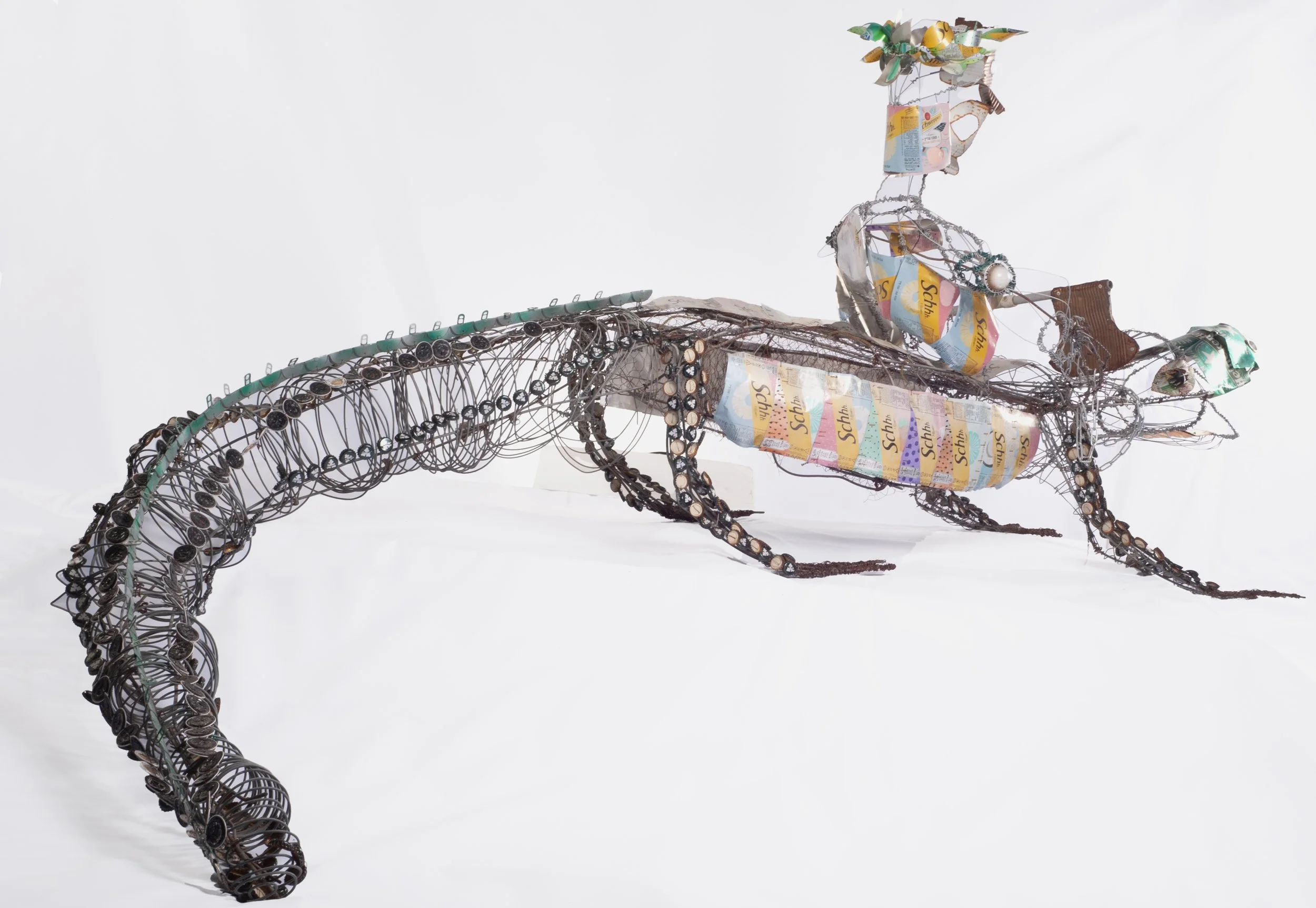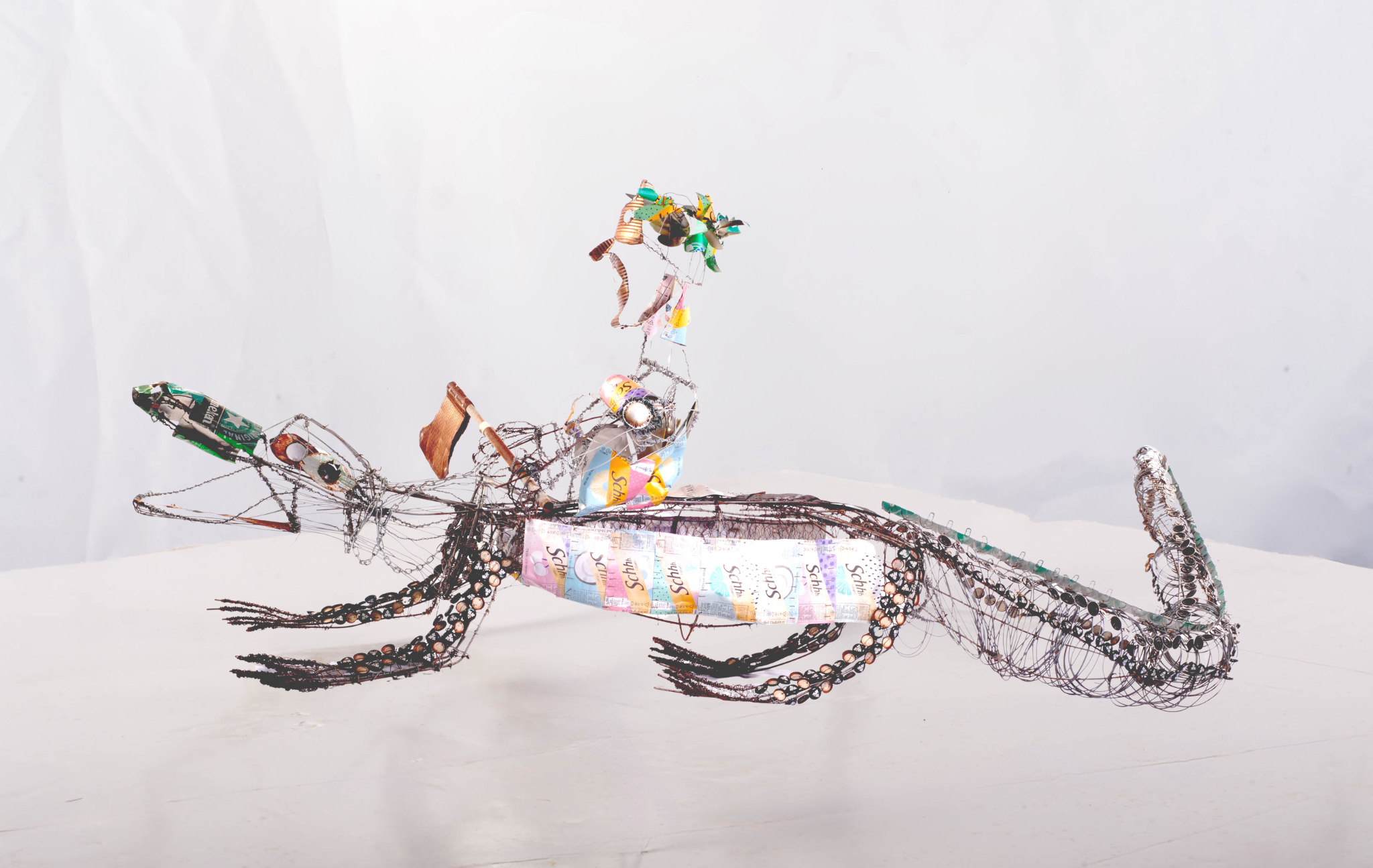George
Saint George ,2020
upgraded 2022
Size: 320 cm length/ 130 cm width/ 125 cm height
Materials: Iron wires, chicken wire, beer caps, tin cans, coffee capsules, wine corks and iron chain
The work was initially built as a sculpture of a Komodo dragon (the largest lizard in the world) and was upgraded to a sculpture of Saint George. I received the inspiration to create a sculpture of Saint George from Bernard Cornwell's book, Harlequin. In this book, the life of the main character, Thomas, is destroyed when raiders attack his village, slaughter the residents, and loot a sacred object that was kept in the village—the spear of Saint George with which he killed the dragon. Thomas vows to kill the raid leader and return the sacred spear, and for this purpose, he enlists as an archer in the English army and finds himself deep in the Hundred Years' War. This story connects to a prominent characteristic of Christianity until the Middle Ages, which involved extensive engagement with sacred objects that connect believers to Christian saints, in this case, the spear of Saint George.
Saint George is considered the most important Christian saint in Orthodox Christianity, and his figure is considered a universal symbol of courage, faith, and willingness to sacrifice. As a result, he is the patron saint of many Christian countries and cities. According to tradition, he was born around the 3rd century to a Christian family; his father was from Cappadocia (now in Turkey) and served as a soldier in the Roman Emperor Diocletian's army, and his mother was from Lod. When the persecutions of Christians broke out, George refused to convert and remained faithful to his beliefs, even at the cost of interrogations, torture, and eventually execution.
The dragon legend tells of a city in Libya that suffered from a fearsome dragon living in a nearby lake, demanding human sacrifices so that it would not destroy the city. When the king's daughter was chosen by lot to be sent as a sacrifice to the dragon, George, who was passing by, went out to fight the dragon, managed to subdue it, and eventually killed it, thus saving the princess and the city's inhabitants, who converted to Christianity as a result.
George was declared a special patron in the Holy Land, especially among local Christian communities. The city of Lod is identified as his burial place, and in the Church of Saint George in the city, which was established during the Roman period, ceremonies in his honor are still held today. His influence permeated deeply into the local culture, to the extent that even among Muslims and Druze in the country, there are traditions associated with his figure. In these traditions, his figure is most often identified with Al-Khidr (the Green One), a holy and mysterious figure mentioned in the Quran as a righteous servant who guides Moses on his journey. In various traditions in the land of Israel and the surrounding area, the figure of George was absorbed into the identity of Al-Khidr, which is also attributed to the prophet Elijah who fought against the prophets of Baal, and is considered a saint who protects travelers, the sick, and the needy. The Druze tradition, which mixes Islamic, Jewish, Christian, and philosophical elements, adopted his figure as one who appears in times of distress to save the innocent and assist the needy. He is perceived as an eternal righteous person, not subject to the laws of time and place, and sometimes even as one who appears to people unexpectedly to provide help and then disappears.
The Arabs in the land of Israel identify the village of Al-Khader as the village where he hid from the Romans, a story reminiscent of the story of Rabbi Shimon Bar Yochai, who also hides in a cave in Meron from the Romans. This is another example of the connection between stories from different cultures that have common sources.
In traditional paintings and sculptures of Saint George, he usually appears riding a white horse or fighting against the dragon. In my sculpture, George and the dragon join together and become one figure. This connects to the difference between the classical perception of good and evil, where evil is external to man and he must struggle against it, and also the absolute good, which is God, is external to him and unattainable. In contrast, there is a more modern or Hasidic perception where good and evil are part of man. That is, if previously the sublime was outside of us, now God is within me. Therefore, unlike classical works in which George fights an external battle with the dragon, in my work, George does not fight against the dragon but fights with the dragon inside him, meaning he rides on the dragon and fights together with it, describing a synergy between wild nature and what is above nature.




